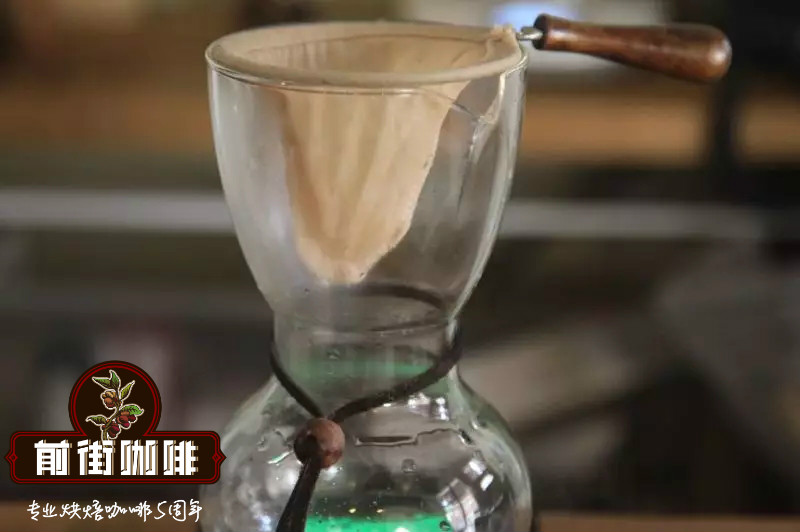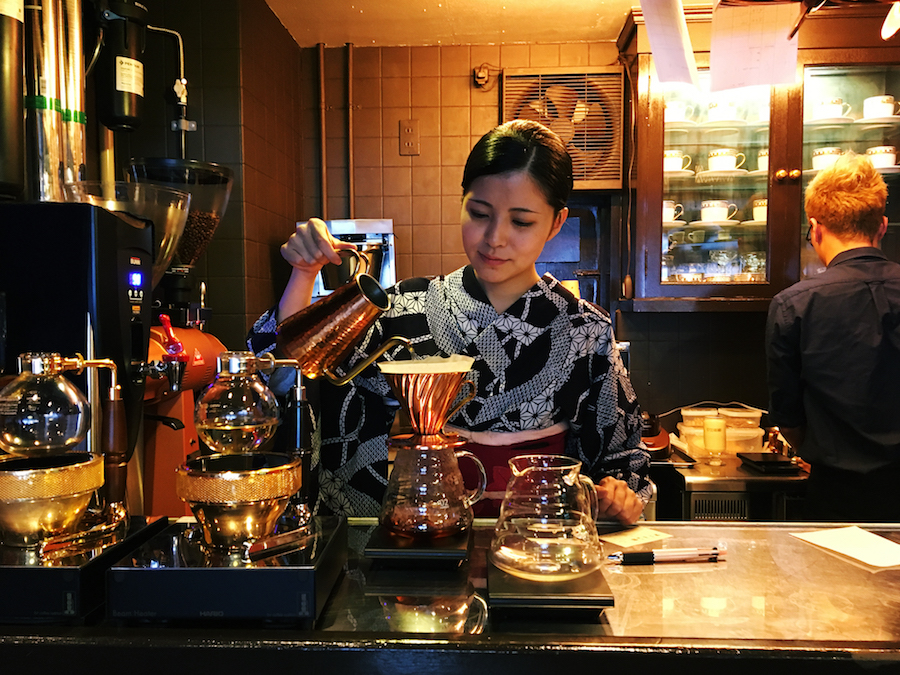What is the process of roasting coffee? What are the levels of roasting of coffee? Roasting of coffee

Professional coffee knowledge exchange more coffee bean information please follow the coffee workshop (Wechat official account cafe_style)
The baking process is roughly divided into three stages, the first two of which can sometimes be merged. The first stage is the beans on the roaster, when the water overflows from the inside of the beans to the surface of the beans, and the coffee beans are dried. There may not be much effect with the eyes at this stage, but the steam from the roaster has the aroma of grass and warm hay. The second stage is followed by moderate baking, and the complex caramelization and Maillard reactions give us a familiar aroma of coffee. Coffee beans in roasting are less dense, drier and more crisp, and the combination of many factors makes them better permeable and easier to dissolve. When the baking is over, the roaster puts down the beans and enters the third stage of cooling and exhaust.
Raw coffee beans themselves do not have any aroma of coffee, only after fried, can you smell the strong aroma of coffee. So the roasting of coffee beans is the transformation process of the internal components of coffee beans, only after roasting to produce ingredients that can release the aroma of coffee, we can smell the aroma of coffee. But in the roasting process of coffee beans, the transformation of ingredients is very complex, after all, coffee beans are organic matter, so the transformation of this component is very complex, and the modern knowledge of organic chemistry can not fully understand.
However, the roasting of coffee beans directly determines the aroma of coffee beans. If the coffee is not roasted well, even if the raw coffee beans are very good, you can't get good ripe coffee beans; as a result, you can't make good coffee. Only with good coffee raw beans, after proper roasting, it is possible to process good coffee cooked beans, and it is also possible to provide a good prerequisite for making good coffee.
Fried coffee beans are roasted at high temperatures, or roasted, to create the coffee's unique color (similar to amber, depending on the degree of roasting), flavor and aroma. Frying turns the green (or yellowish) raw coffee beans into the familiar tea-brown coffee beans. High-quality fried roasting refers to the ingenious expression of the aroma, sour and bitter ingredients of raw coffee beans.
A series of chemical changes occur in the process of baking. After about 5-25 minutes of baking (depending on the temperature selected), the green coffee beans lose some humidity and turn yellow. In this process, the coffee beans will swell, changing from a strong, high-density raw bean to a low-density fluffy state. After this process, the coffee beans will about double in size and begin to show a light brown after stir-frying. After this stage is completed (after about 8 minutes of baking), the calories will be reduced. The color of the coffee soon changed to dark. When the default baking depth is reached, cold air can be used to cool the coffee beans in order to stop the baking process.
Baking is roughly divided into shallow baking (Light), medium baking (Medium), urban baking (City) and deep baking (Deep).
Light roasted coffee beans: will have a strong smell, very crisp, high acidity is the main flavor and slightly mellow.
Medium-roasted coffee beans: have a strong mellow, but also retain a certain degree of acidity.
City-baked coffee beans: the surface is dark brown, the acidity is replaced by slight bitterness, and most of the flavor has been destroyed.
Deep-roasted coffee beans: dark brown in color and oily on the surface. For most coffee beans, the alcohol content increases significantly and the acidity decreases.
In fact, roasting coffee is a way of processing food. The roasting of professional coffee is the personal expression of the roaster. The biggest problem when you first come into contact with professional coffee beans with different roasting degrees (SPCIAITYCOFFEE) is the name of the roasting degree. For example, CITY, FUIICITY, FRENCH, ESPRESSO, etc., all produce different baking colors because of the different baking machines and producing areas.
In addition, some roasting levels are named after mixed coffee: for example, ESPRESSO is a coffee with a specific roasting degree for making ESPRESSO, and even if the color looks the same, it may have a completely different flavor. Therefore, the selection of the type of beans, baking temperature and baking method, and the length of baking time are the main factors that determine the final flavor.
Stage
The roasting method of professional coffee is usually divided into the following eight stages.
1. Very shallow baking (LIGHTRoast):
The degree of baking; very shallow baking, also known as shallow baking.
The lightest roasting degree of all roasting stages, the surface of the coffee beans is a light cinnamon color, its taste and aroma are insufficient, this state is almost undrinkable. It is generally used for testing and seldom for tasting.
2. Shallow baking (CINNAMONRoast):
Degree of baking; shallow baking, also known as cinnamon baking.
The general baking degree, showing cinnamon color on the appearance, the smell of green has been removed, the aroma is OK, and the acidity is strong, which is a common roasting degree of American coffee.
3. Micro baking (MEDIUMRoast):
Baking degree; moderate baking, also known as micro baking.
Medium baking heat and light baking are both American, in addition to sour taste, bitterness also appears, the taste is good. It has moderate aroma, acidity and mellowness, and is often used in the baking of mixed coffee.
4. Medium baking (HIGHRoast):
Baking degree; moderate micro-deep baking, also known as concentration baking.
Belongs to the moderate micro-deep baking, the baking degree is slightly stronger than the slight medium baking, the surface has appeared a little thick brown, the bitterness also becomes stronger. Coffee tastes sour and bitter, with good aroma and flavor, and is most often loved by people in Japan and Central Europe. (blue Mountain Coffee)
5. Medium and deep baking (CITYRoast):
Baking degree; medium-deep baking, also known as urban baking.
The most standard degree of roasting, bitterness and acidity are balanced and are often used in French coffee. (Brazil, Colombia)
6. Deep baking (FULL-CITYRoast):
Baking degree; micro-depth baking, also known as deep city baking.
The baking degree is slightly stronger than the medium depth, the color becomes quite dark, and the bitter taste is stronger than the sour taste. It belongs to the Central and South American baking method, which is very suitable for preparing all kinds of iced coffee.
7. Very Deep Baking (FrenchRoast):
Degree of baking; deep baking, also known as French baking.
Also known as French or European baking, belongs to deep baking, the color is thick brown with black, sour taste can not be felt, especially in Europe, France is the most popular, because the fat has infiltrated to the surface, with a unique flavor, very suitable for coffee Oulei, Viennese coffee.
8. Very Deep Baking (ItalianRoast):
Degree of baking; very deep baking, also known as Italian baking.
Also known as Italian baking, baking degree before carbonization, there is a scorched taste, mainly popular in Latin countries, suitable for fast coffee and cappuccino. Most of them are used in Espresso coffee series.
END
Important Notice :
前街咖啡 FrontStreet Coffee has moved to new addredd:
FrontStreet Coffee Address: 315,Donghua East Road,GuangZhou
Tel:020 38364473
- Prev

"non-boutique coffee" must be very bad? Are all beans less than 80 points rotten?
Professional coffee knowledge exchange more coffee bean information please pay attention to the coffee workshop (Wechat official account cafe_style) supermarket can not buy good coffee? Why do so many people complain about Starbucks coffee beans? If you have your own bakery, the coffee must be good? If we want to know these things, we need to clarify a good objective definition. But in the world of wine or coffee,
- Next

What is the definition of the name of coffee
What is the name of coffee? coffee beans are named after countries: Colombia (Columbia), Guatemala (Guatemala), El Salvador (El Salvador), Bolivia (Bolivia), Nicaragua (Nicaragua) after producing areas: Yirgacheffe, under Sidamo
Related
- Beginners will see the "Coffee pull flower" guide!
- What is the difference between ice blog purified milk and ordinary milk coffee?
- Why is the Philippines the largest producer of crops in Liberia?
- For coffee extraction, should the fine powder be retained?
- How does extracted espresso fill pressed powder? How much strength does it take to press the powder?
- How to make jasmine cold extract coffee? Is the jasmine + latte good?
- Will this little toy really make the coffee taste better? How does Lily Drip affect coffee extraction?
- Will the action of slapping the filter cup also affect coffee extraction?
- What's the difference between powder-to-water ratio and powder-to-liquid ratio?
- What is the Ethiopian local species? What does it have to do with Heirloom native species?

